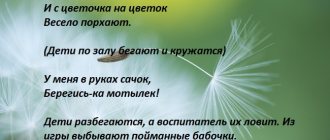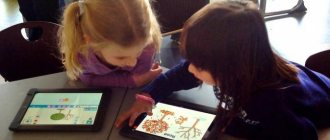Organization of walks (from work experience)
What is a walk? And how to organize it? Many novice educators have difficulty planning a walk. How different should the activities of children be in the kindergarten area? These are active observation games and sports entertainment, labor, and independent activities for children.
The better the conditions on the site are thought out, the more clearly the regime is implemented, the denser and more interesting the children’s activities. Planning a walk helps a young teacher to evenly distribute program material, avoid frequently repeated topics, enriches preschoolers with knowledge, develops curiosity, encourages exploration, and influences the formation of positive relationships among peers. A teacher is an organizer of observations, a participant in games and fun, and a leader of children’s activities.
Organization of walks.
The process of raising children is continuous.
Great potential opportunities for the comprehensive harmonious development of a child’s personality are inherent in the process of educational work with children in a walking environment. The main goal of the teacher’s pedagogical work during a walk is to provide active, meaningful, varied and interesting activities for children: games, work, observation, during which a children’s team is formed, positive behavior skills are learned and developed, and children’s ideas about the surrounding nature and social life are accumulated.
A walk should provide relaxation to the child, relieve stress after classes and create a cheerful mood in him, which in turn provides the appropriate tone for the successful physical and mental development of the child in other conditions and types of activities.
An indispensable condition for the successful development and education of preschoolers during a walk is their simultaneous mastery of mental and practical actions. This can be successfully resolved through systematic observations planned in advance by the teacher. Daily observations on walks enrich children's ideas about the natural world, people (their work, relationships), and enrich children's aesthetic ideas.
Thus, observation is one of the main components of the walk.
Children should be involved in active mental activity, in completing tasks to improve their skills, ability to navigate the kindergarten area, etc.
During the walk, they plan to observe objects and phenomena of social life and nature, observe the work of adults, the life of the city, animals, as well as the work activities of the children themselves. In the calendar plan, the teacher specifically indicates what the children will observe, for what purpose, what type of work they will do, and how the responsibilities will be distributed among them.
Thus, the structure of the walk consists of the following components:
— Various observations (goal) (didactic tasks);
— Labor actions of the children themselves (goal);
— Outdoor games and play exercises;
— Individual work in physical education;
— Independent activity of children.
Each of the required components of the walk takes from 7 to 15 minutes and is carried out against the backdrop of children’s independent activity. the sequence and duration of different types of activities should vary taking into account specific conditions: time of year, weather, age of children and the nature of their previous activities. So, if before the walk there were activities that required mental stress from the children, then it is advisable to start it with the organization of outdoor games or sports entertainment, labor. And vice versa, if the walk was preceded by physical and musical activities, then it is better to start it with calm independent activity.
The main thing is that each of the components of the walk contributes something unique to the development and education, in the formation of the personal qualities of preschoolers.
Against the background of children playing independently, the teacher can tell and show something to them, communicate with one or two on a topic that interests them, organize individual games and entertainment, and observe with a subgroup of children some unusual phenomenon or event that they themselves noticed. The main thing is to make sure that you don’t get bored while walking.
Walk “Nature Has No Bad Weather”
Purpose of the walk
- to activate children’s knowledge about animals and plants, to introduce them to the concept of “weather”, to the influence of weather changes on plants, animals and people, to promote the formation of the ability to assess the condition of surrounding plants and animals, and to teach them to conduct phenological observations.
Before going on a walk, children should be taught about the factors that make up the weather. Make a sample nature diary, show how to record known natural phenomena in a diary using symbols. Tell us how to dress for a walk in different weather. Find out what birds and insects that live in the school area the children know. Consider illustrations depicting famous birds and insects.
With this walk you should begin your daily observation of the weather and seasonal natural phenomena. At the beginning and at the end of the walk, the teacher can ask the children what the weather is like, whether there have been any changes in the weather during the walk, and how the children determined this. Did they take into account the state of the sky (clear, presence of clouds), the presence of wind (quiet, windy), temperature (warm, cold, cool). What do the plants look like (cheerful, sad, drooping), birds (ruffled, joyful, anxious), do insects fly, how does the weather affect a person (chilly, hot, what is your mood). Then ask the children to note the signs of autumn.
Complete the game task “Natural absurdities” and play the game “Blind Man’s Bluff in Circles”.
"Natural absurdities"
While walking along a certain route, children are asked to find objects of non-natural origin that the teacher has previously placed on this site. After completing the route, the most vigilant traveler is determined by the number of absurdities seen. Then the teacher and the children walk along the route again, noting these absurdities with them.
"Blind Man's Bluff in Circles"
I blindfold the driver, chosen according to the counting rhyme. Within a radius of 3-5 steps around the driver, the players draw small circles and stand in them. One of the players circles the driver in place so that he loses the direction in which to look for circles.
The driver walks at random, and the players run from circle to circle until he comes close to one of the circles. At the command of the leader, everyone stops and does not move from their place. The driver stretches his arms forward, trying to touch the person standing in the circle, and he crouches, dodges, without leaving his place. Having finally found the person hiding, the driver feels him and calls his name. If the driver makes a mistake, he continues to drive. In case of three failures in a row, a new driver is chosen.
The player who moved from his place after the driver approached the circle must change him.
After the walk, children record their observations of the weather in a nature diary.
As a senior teacher, I systematically study the work of educators with children during walks, provide them with methodological assistance in planning its content, techniques and methods of guiding various children's activities. I also make sure that in the calendar plan teachers indicate what attributes and toys will be needed for children to play, i.e. take-away materials. Because, based on this, children have a desire to play one or another game (sailor caps, binoculars for “sailors”, steering wheel for a “driver”, etc.
The content of evening walks should be planned taking into account all the children’s previous activities. Observations of games, labor, physical exercises and outdoor games are planned. However, it is necessary to keep in mind that in the evening you should not play games of great mobility that excite the nervous system of children.
Literature:
1. T. G. Kobzeva. Organization of children's activities during a walk.
2. Kholodova I. A. Children about nature.
3. M. V. Lucic. Classes with children of senior preschool age on the topic: “Spring. Insects, migratory birds."
4. E. A. Babenkova, T. M. Paranicheva. Outdoor games while walking.
Walks in kindergarten
In kindergarten, children are required to go for walks. The topic of walking is often discussed by parents. Moreover, they express a variety of opinions.
For example, mother Lena (son Vladik is 5 years old) believes that walking in cold weather is prohibited. Frost or wind, cold rain - all this leads to colds. Therefore, it is better to sit in a group in bad weather. But in good weather, of course, you need to go for a walk.
But mother Marina (son Alyosha is 3 years old) thinks that we should go for a walk in any weather. Just do it in doses - little by little. And during a walk you can thoroughly ventilate the room. But teachers often do not take the children outside; they sit in the group all the time and do not breathe fresh air.
Mom Maria (daughter Alexandra – 4 years old) shares the same opinion. She believes that sitting in a group without a walk, children will get infected from each other faster. It is no secret that parents often bring children who have not fully recovered to kindergarten. Therefore, germs and viruses accumulate in one place. That's why children get sick. And if you walk every day, germs die in the fresh air - and the children will be healthier.
Mom Natalya (daughter Dasha - 2.9) believes that teachers dress the kids poorly. They do not make sure that scarves are tied and all buttons are fastened. Therefore, children quickly get sick when walking in bad weather. In addition, the little ones cannot fully dress themselves; teachers help some, dress others completely. All this takes time, so children who are ready earlier than others begin to sweat - a cold is guaranteed. Therefore, Natalya believes that children should only go for walks in good weather.
As you can see, there are many opinions and they are all different. However, there are also standards that kindergarten employees must adhere to. What do the regulations say?
According to the Decree of the Ministry of Health of the Republic of Belarus No. 8 of January 25, 2013, children should walk outdoors 2 times a day. The total duration of the walk is 3 hours 20 minutes - 4 hours.
At the same time: “The head of a preschool education institution may decide to reduce the duration (or prohibit) outdoor walks for pupils in unfavorable weather conditions (rain, hurricane, other man-made emergencies), as well as in conditions of air speed of more than 3 m/ sec and ambient air temperature - 15 °C and below - for pupils under the age of 3 years, at an atmospheric air temperature of -18 °C and below - for pupils aged 3 to 7 years."
During the walk, it is necessary to provide children with physical activity and appropriate clothing, depending on weather conditions.
Thus, children should go for a walk, but if the weather is bad, the leader may decide not to take the kids out for a walk. However, there must be reasons for this: very low air temperature, hurricane winds or rain. It’s just that children cannot stay in the group all the time.
In addition, during a walk it is necessary to ventilate the room. According to the above decree, corner and through ventilation can only be carried out if there are no children in the group. The duration of ventilation may vary depending on air temperature, wind and other indicators. Moreover, this procedure should end half an hour before the children arrive in the group.
But one-way ventilation can be carried out in the presence of children:
“in the warm season - continuously;
in cold weather - until the air temperature in the premises drops to +18 °C for pupils over 3 years of age and to +19 °C for pupils under 3 years of age.”
But, of course, through ventilation (which is carried out in the absence of children) is more effective. Therefore, children should definitely go for a walk if the weather is not too bad. And in this case, the group will have a healthier environment.
Photo from the site www.43foto.ru



